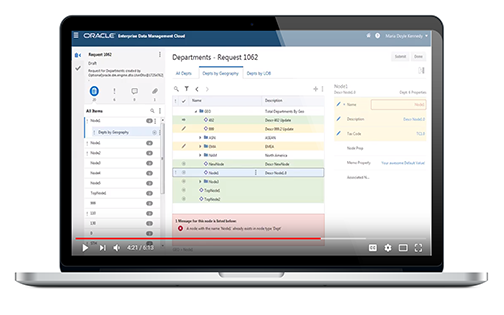Oracle announced last week that it’s preparing to release the long-awaited cloud version of Data Relationship Management (DRM). The new product is called Enterprise Data Management Cloud.
Data governance is more important than ever, as many organizations are choosing to keep some of their systems on-prem and move others to the cloud. A data governance tool organizes siloed data across different systems and transforms it into timely, accurate, and consistent master data. Organizations that try to do this manually leave themselves more vulnerable to data quality issues.
To date, the gold standard for data governance tools has been Oracle DRM. So, what can we expect from Oracle’s new cloud product? In this blog post, we’ll give you an overview of what’s coming and the features that will be included in the Enterprise Data Management Cloud.
Overview
As mentioned above, a data governance tool is meant to align your applications, keeping your data consistent across the enterprise. This is no different with Oracle’s data governance tools, which allow you to utilize self-service enterprise data maintenance, rationalization, and sharing. What’s different about Enterprise Data Management Cloud is that it layers on the additional benefits of the cloud — fast to deploy, no upfront hardware fees, and a monthly user fee.
Changes in your organization happen fast, and it can be hard to adapt to those changes. With the Enterprise Data Management Cloud, you can easily model M&A scenarios, while considering things like restricting, reorganization, and standardizing your chart of accounts.
We’ve talked about how Oracle DRM can help you with cloud adoption. The same is true for the Enterprise Data Management Cloud, where you can map enterprise data elements across all cloud environments, whether it’s public, private, or a hybrid cloud.
The Enterprise Data Management Cloud also gives you one place to see all your enterprise data. You can support any enterprise data, including:
- Master data
- Reference data
- Dimensions
- Hierarchies
- Business taxonomies
- Associated relationships
- Mappings
- Attributes
Features
Enterprise Data Management Cloud allows you to gather your enterprise data from your applications in one place. It does this through…
Application Adapters
You can use built-in application adapters for the Oracle cloud or custom application adapters to connect your enterprise applications. Registering these applications is easy with question-and-answer wizards. You can also generate metadata instantly to view application-specific views, and import from or export to your connected applications.
Import Dimensions
You can easily import lists and hierarchies from connected applications. You also can load dirty data that you don’t have to validate when it’s entered.
Validate Viewpoint
Improve the quality of your data by validating entire viewpoints within an application or domain. You can also create requests to make changes, while recording them for auditing purposes.
REST API
Enterprise Data Management Cloud allows you to use granular REST API interfaces so you can automate and integrate the service within the enterprise data fabric.
The features that allow you to make changes to enterprise data elements include:
Request
This feature allows you to create or change existing enterprise data, relationships, or attributes.
Validate
The validate feature allows you to authenticate system checks and specified application validations.
Visualize
You’re able to model your request items and related actions against your target structures so you can understand what impact the change will have and prioritize accordingly.
Submit
You can also easily submit new items and make changes to existing items, using a single request. This ensures your submissions are consistent.
Enterprise Data Management Cloud also allows you to make the same changes across various business perspectives. You’re able to do this by…
Validation
You can run validations in real time during a request submission or run validations throughout viewpoints before exporting to your applications.
Compare
You’re able to easily compare alternate hierarchies within your application or business perspectives, allowing you to understand differences in data. You can rationalize these differences using a drag-and-drop interface.
Rationalize
You’re able to drag and drop separate, distinct nodes from the source to your targeted viewpoints within applications. This allows you to blend alternate hierarchies or rationalize specified domains across your enterprise applications. You can also automatically align associated properties based upon your configuration. Lastly, the rationalize features ensures that any descendants of rollup points harmonize automatically among alternate hierarchies.
The last set of features allows you to easily digest changes among your downstream business applications. These features include…
Export
You can export dimensions and mappings to consuming applications. You can integrate one or more connections for registered applications or you can download to file for consumption in target applications.
Download
You can download any viewpoint to a desktop file, allowing you to collaborate, share, or even conduct offline maintenance.
Automate
You can use the Oracle cloud’s EPM Automate Utility to script automated integration with consuming applications using a REST API.
Audit
This tool allows you to review detailed change histories by browsing audit trails for completed requests.







